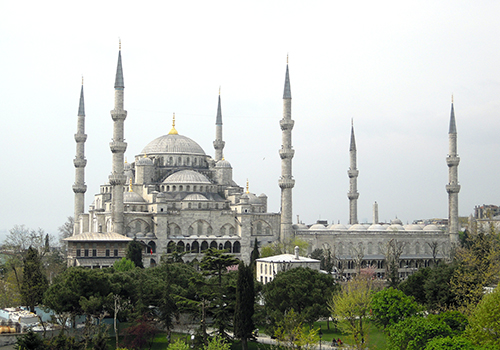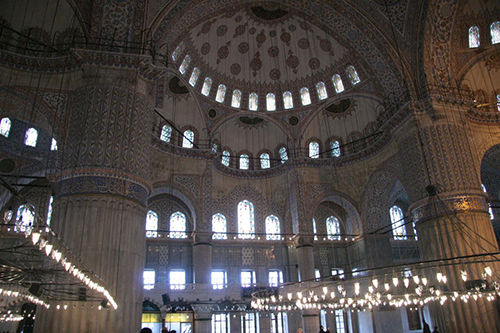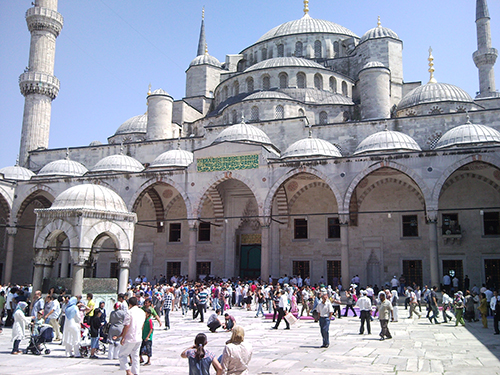Gem of the Month: The Blue Mosque
Istanbul is yet another one of the places on my “to see” list that I probably will never get to see. One of the big draws for me to that city—besides its amazing history as the former Roman capital (“Rome of the East”) (ca. 350s–1453)— is its transformation into a major center of architecture, painting, and miscellaneous art forms under the Ottoman rulers (ca. 1453–1926). There are several fabulous mosques there, influenced in a big way by the centrally planned (formerly a church) Hagia Sophia that was built under the Byzantine emperor Justinian (482–565 CE).
 |
| Sedefkar Mehmet Aga (ca. 1540–ca. 1623, Turkey), Mosque of Sultan Ahmet I (“Blue Mosque”), Istanbul, 1609–1616. Photograph by Arnstein Ronning. CC BY-SA 3.0. (8S-23165) |
The Mosque of Sultan Ahmet I was the design of Mehmet Aga, a pupil of the great Ottoman architect Sinan (1489–1588), builder of the Süleymaniye Mosque (1550–1557) in Istanbul and Selimiye Mosque (1568–1574) in Edirne, Turkey. The chosen site, the foundations of the former palace of the Byzantine emperors, was symbolic of the subjugation of Christendom in Istanbul. The mosque of Ahmet I faces Hagia Sophia, at the time the most venerated mosque in Istanbul, converted to Islam shortly after the Ottoman's conquered Istanbul in 1453.
The continuation of the domed design seen in Sinan’s buildings was an indication of the religious conviction of the mystical nature of mosque architecture. The basically square interior was flooded with light. A series of half domes, curtain walls, and four main columns/piers support the main dome. The plan is quatrefoil, meaning the square is subdivided on four sides with half-circles. Unlike the pillar supports for the central domes of the Suleyman and Selimiye mosques, the supporting piers in the Blue Mosque are thick and somewhat clumsy.
 |
| Sedefkar Mehmet Aga (ca. 1540–ca. 1623, Turkey), Mosque of Sultan Ahmet I (“Blue Mosque”), interior, Istanbul, 1609–1616. Photograph by Zeledi. Public domain. |
The Sultan Ahmet I Mosque was built in close proximity to Hagia Sophia in an effort to dwarf its splendor. Although the Sultan Ahmed I Mosque is not as large as Hagia Sophia, it competes with the church in Mehmet Aga’s design. Most notable are the 260 windows that flood the interior with a mystic light. This light, which gives the mosque its nickname, The Blue Mosque, reflects off the 22,000 faience tiles decorating the interior. The mosque contains an imperial lodge, madrasa (religious school), and double-storied shops. The six minarets are a unique feature in mosque construction.
The Ottoman Empire was a vast Turkish sultanate that covered Turkey, northeast Africa, southwest Asia, and southeast Europe. It was founded in the 1200s by Ottoman Turks and spread rapidly in the 1400s, taking over the areas once controlled by the Byzantine Empire (including Greece and Egypt), Arabia, and Syria. Mehmet I (died 1421) restored unity to the Ottoman Empire after the civil war that lasted from 1402 to 1413.
After the Ottoman occupation and conquest of Istanbul (Constantinople at the time) in 1453, they were impressed by the grandeur and design of Hagia Sophia, the former mother church of the Byzantine Empire that dated to the 500s CE. Centrally planned, domed mosques began to be built as early as the 1500s based on the fundamental design of Hagia Sophia.
During the 1600s, the Ottoman Empire was weakened both internally and externally by costly wars with Russia, the Austro-Hungarian Empire, Iran, and Poland. Ahmet I (died 1617) became sultan in 1603 at the age of fourteen. Not an experienced military leader, his disastrous battles in 1606 soon cost the Ottomans the area from Georgia and Azerbaijan to Iran and the annual tribute paid by Austria. Thereafter, Ahmet I concentrated on his religious leadership and the arts. He was the first Ottoman ruler in three decades to build a new mosque in the capital.
 |
| Sedefkar Mehmet Aga (ca. 1540–ca. 1623, Turkey), Mosque of Sultan Ahmet I (“Blue Mosque”), forecourt, Istanbul, 1609–1616. Photograph by Randam. CC BY-SA 3.0. |
In the forecourt or narthex of Christian churches there was traditionally located a baptismal font to anoint one’s head with the sign of the cross before entering the blessed space. In Islam, the forecourt of the Blue Mosque extends the width of the façade. Based on the example of Süleymaniye Mosque, it differs in the two minarets added at the corners. Pictured above is one of two ablution tanks in the forecourt. Because the mosque is a sacred space, it has been traditional for worshippers to wash exposed parts of their body before entering in this order: hands, mouth, nose, face, arms, top of head, ears, and feet. This ritual washing is called wudu or wuzu.
Correlations to Davis Programs: The Visual Experience 3E: 14.2; Discovering Art History 4E: 4.7, 7.3; Discovering Art History Digital: 4.7, 7.3


Comments